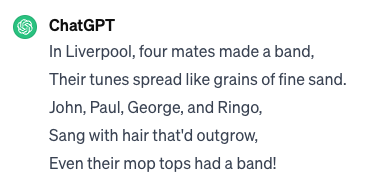
Top 8 Generative AI Skills for Freelance Writers
It doesn’t seem that long ago that A.I. was just a Spielberg movie, yet here you are, searching for answers on how to use generative AI skills in your freelance writing career. However hard – and scary – it might be to grasp the leap from fiction to fact, we’re here to reassure you that it is possible to work with the technology rather than fear that it will put you out of work.
In this post, we’ll look at what generative AI is and guide you through the top eight skills you should develop to make it work for you.
What Is Generative AI?
Let’s start with the definition: What do we mean by “generative AI”? Basically, the term covers the use of artificial intelligence (the “AI” bit) to generate (hence “generative”) text, images, or other media.
But how does it do that? Taking human prompts, generative AI models, such as ChatGPT, use the information they receive in vast data sets to recognize patterns of human expression and information to produce the requested result (say, a limerick about the Beatles).
It’s the production of text that we’ll concentrate on in this post, as that will be the most relevant to you as a freelance writer. If you want to have a look at its other uses – the production of images to insert in your articles, for example – then have a look at one of the other tools, such as DALL-E.
And that limerick about the Beatles? Here it is:

If you needed any further convincing that, used alone, generative AI is no threat to you as a writer, there it is. With the necessary skills, however, you can make it work for you.
Which Generative AI Skills Should You Develop?
Used well, generative AI can be a real time-saver. Used poorly, it can land you in deep trouble. How can you make it work for you rather than against you? Here are the top eight skills we think you should develop:
1. Familiarization with the Tools
To get the best out of any new tool, you need to know what it can do. When it comes to using generative AI to produce text, that means trying out popular tools such as ChatGPT, Jasper AI, and Google Gemeni. For our review of the top five, take a look at this post.
Whichever tool you choose – and you don’t have to pick just one – play around with it! There’s no better way to find out how to use a tool than to try it out. Maybe start by asking it to write a limerick about the Rolling Stones (for balance).
2. Writing Effective Prompts
As you play around, you’ll soon notice how much the result depends on the wording of the prompt. The skill you need to develop here is to notice the way your prompts are interpreted so that you get the closest to your desired result on the first attempt.
This skill will save you time, which is probably why you turned to AI in the first place. For example, asking for a limerick about the Beatles saved us from receiving a work of epic poetry, but it was still necessary to add a second prompt – for it to be humorous – to arrive at something … nearly funny.
3. Knowing When to Stop
When you have a tool capable of writing text that mimics human expression, it can be tempting to make it write the whole thing for you. You probably wouldn’t even have time to make a cup of tea before it was done. Just copy, paste, and publish, right? Wrong.
While generative AI models may be able to mimic human expression, they lack human experience; the content they produce tends to sound flat and repetitive rather than engaging. At best, therefore, asking AI to do your writing for you will do you a disservice.
And at worst? That’s where you’ll need the next skill.
4. Fact Checking
Although Alexander Pope famously wrote that “to err is human,” he was writing long before the advent of computers. And if you were in any doubt as to their fallibility, a quick look at the news should convince you.
Generative AI is just as prone as humans to getting facts wrong. To test this out, we asked for a cool fact about the Beatles and received this result:

Three songs reaching number one in a single year? Hardly “an incredible feat.” A quick check of Billboard.com shows that they had six number ones in 1964.
Developing – and maintaining – your fact-checking skills is key to becoming a credible writer and vital if you’re to make the best use of AI-generated text.
5. Editing and Refining
Maybe you got stuck and asked the AI tool to write an opening paragraph for you. Whatever its take on human expression and the tone of voice you’ve prompted might be, it’s unlikely that the result will have the same personality as if a human had written it. This is where you need to flex your editing muscles. Editing is a key skill to any writer, whether they use AI or not.
Read over what the AI tool produced and – as well as checking the facts – rewrite it in your own words. Maybe what the AI tool wrote will spark your own insights. And if your client’s brand voice allows, you could inject some humor to further connect with the reader on a human level.
6. Recognizing Its Place in the Process
So, if generative AI is flaky with facts and poor with personality, what good is it to a writer? The skill to develop here is recognizing where its responsiveness can be an asset: It doesn’t suffer from writer’s block.
If you have a regular blog to populate, there will come a time when you run out of ideas. Where in the past you might have turned to colleagues, friends, family, or even the cat for inspiration and received none, you can use one of the AI writing tools instead – not to write your piece but to generate some ideas.
Similarly, you can prompt the AI tool of your choice to suggest an outline for a piece on the topic you’ve been given and even specify the length required.
The results may not be exactly right for you, but they will be instant and might just be enough to provide the inspiration you need. And, having worked on your editing and refining skills, you can improve the AI-generated text.
7. Improving Your SEO
Having put in the time and effort to produce your best work, you’ll want people to find and read it. For online content, this requires good search engine optimization (SEO).
But how do you know what a search engine will look for? In this case, the AI tool is the expert, so prompt it to suggest some good keywords. Having gotten those, it’s down to your skill as a writer – using those editing and refining skills – to incorporate them naturally into your content.
Maybe your brief includes writing a meta description or social media caption, and you’re struggling to include the necessary information within the restricted character limit. You can prompt the AI tool to suggest a few and then edit and refine them.
8. Staying Up-to-Date
If the advancement of AI from Spielberg sci-fi to widespread usage has taught us anything, it’s that technology is changing at a rapid pace. When you’re looking to work as a freelance writer, this means making sure that you are, at the very least, aware of the latest developments so that you’re ready to adapt and remain available for work.
And you don’t just need to keep abreast of the ways in which AI may be used: Its expansion in usage raises ethical and legal issues, such as plagiarism, copyright, and data protection. It’s vital to keep up to date on how AI can be legitimately used in content creation so that you avoid a costly mistake.
AI Prompting For Writers And Editors
These skills will help you to make generative AI work for your freelance writing career – and you may find that they open up more opportunities for work. Just remember: Generative AI is best used to provide inspiration, not the end result. The freelance writer is you – a highly skilled human.
If you think you may be lacking in some of the skills we’ve covered or simply want to brush up on what you already know, why not take our new AI Prompting For Writers And Editors course? We’ve designed it to help writers and editors master some of the skills listed in this post. It’s beginner-friendly – no previous AI experience required!





Your email address will not be published.